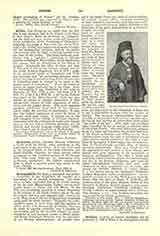

Archimandrite (Gr. archo, I command, and mandra, a sheepfold), in the Greek Rite the superior of a monastery, or of several monasteries. The term seems to have originated during the fourth century in the far East (Mesopotamia, Persia), and to have spread thence to Egypt and Asia Minor. In the fifth and succeeding centuries it occurs frequently in the writings of the Greek Fathers, also in the acts of councils, and was even adopted quite extensively in the West where it did not disappear from occasional usage until the ninth century. Originally the archimandrite seems to have been only the superior or abbot of his own monastery; gradually, however, he came to exercise authority over a number of monasteries, and by the eleventh century the archimandrites of such monastic centers as Mount Athos, and Mount Olympus in Bithynia, were the equivalent of our Western abbots-general. At present there are in the Greek Church two kinds of archimandrites, the original monastic officers exercising jurisdiction in their respective monasteries, and honorary archimandrites and well-educated priests attached to the chanceries of the great patriarchates (e.g. Constantinople), or at the head of certain branches of temporal administration; in a word, not unlike the Roman prelates or the principal officers of a Western diocese. It is from the ranks of these quasimonastic priests that the bishops are often selected, when not taken directly from the monasteries. The archimandrite is appointed by ecclesiastical authority (patriarch, metropolitan, bishop), also, in Russia, by the Holy Synod, and in some monasteries by election.
He has the right to wear a pectoral cross, the epigonation in the celebration of Mass, and to sign a cross before his name after the manner of bishops. The monastic archimandrites have also the right to the pastoral staff, and to a peculiar mantle having four squares of embroidered cloth called “the tables of the law”. Their rights and privileges differ somewhat by law or custom in different parts of the Greek Church. The usual distinction, common to all, is a black veil tied about the peculiar headgear of the Greek ecclesiastic and falling on the back. Archimandrites enjoy the right of precedency among other priests; among themselves this right is regulated by the dignity of their origin; thus an archimandrite of Constantinople outranks those of inferior episcopal appointment. There is a formal rite for the appointment and creation of these officers, performed with more solemnity in the installment of monastic archimandrites. The office is found not only in all Greek Churches subject to Constantinople, but also in the Russian, Bulgarian, and other so-called autocephalous Churches, that once owed allegiance to that patriarchal see; it exists also among the Catholic (Melchite or Uniat) Greeks. It is not known among the Armenians, Chaldeans, Syrians, Maronites, Copts, or Abyssinians. An important survival of it in the West is seen in Sicily, where, after the time of Roger II (1130-54), the archimandrite of the great Basilian Abbey of San Salvatore in Messina enjoyed extensive, even quasiepiscopal, jurisdiction, eventually, however, becoming a secular or commendatory abbot (Ferraris, Bibl. prompta, s.v.). This Basilian monastery was suppressed by the Italian government.
ANDREW J. SHIPMAN

